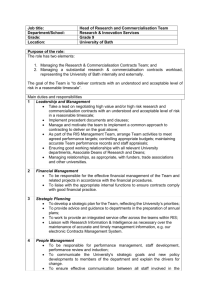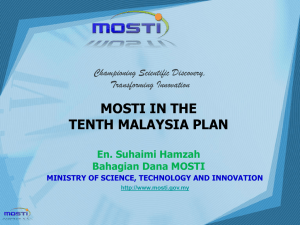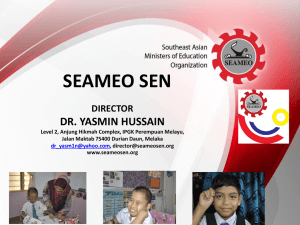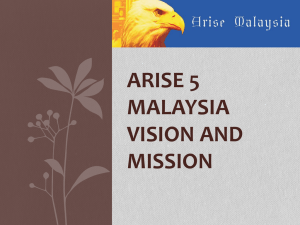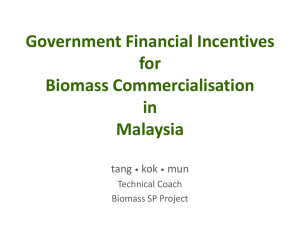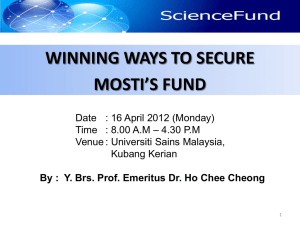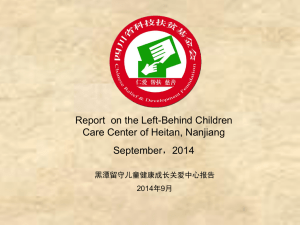Malaysia - ASEAN-EU STI Days 2014
advertisement
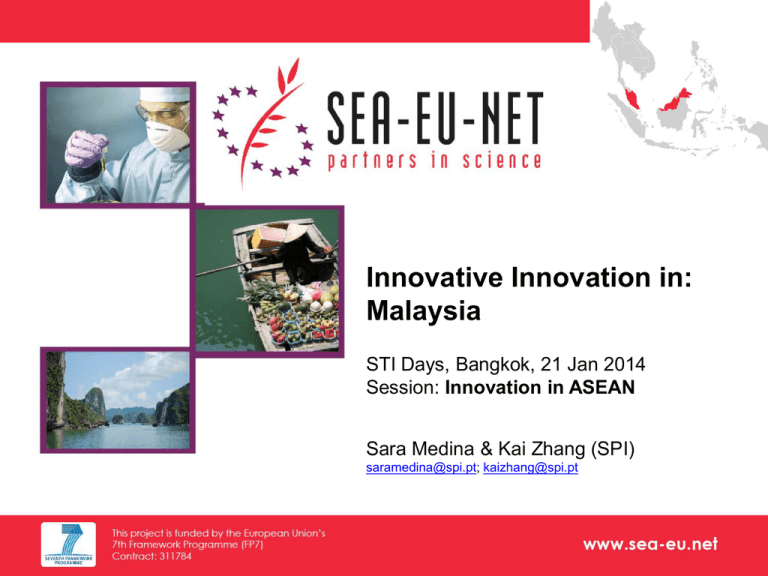
Innovative Innovation in: Malaysia STI Days, Bangkok, 21 Jan 2014 EU-ASEAN S&T cooperation to in jointly tackle Session: Innovation ASEAN Title of Presentation societal challenges Subtitle/other information Sara Medina & Kai Zhang (SPI) saramedina@spi.pt; kaizhang@spi.pt www.sea-eu.net 1 Agenda I. Context in Malaysia II. Innovation Support Instruments III. Observations www.sea-eu.net 2 Agenda I. Context in Malaysia II. Innovation Support Instruments III. Observations www.sea-eu.net 3 I. Context in Malaysia Overview • Malaysia is ranked 15th in the International Institute for Management Development (IMD) World Competitiveness Ranking in 2013 • Malaysia is 2nd to Singapore in terms of Gross Domestic Product (GDP) per capita within ASEAN, being a middle-income country according to United Nations (UN) standards • Malaysia has a Gross Domestic Expenditure on Research and Development (GERD)/GDP rate of 1,07% (2011), 2nd to Singapore within ASEAN • Malaysia ranks 32nd out of 142 countries in the Global Innovation Index • Malaysia has among the world´s highest rate of Private Sector Proportion of R&D Expenditure : 56,7% (2011) Source: MASTIC National R&D Survey 2012/Innovation in Southeast Asia, OECD, 2013/ Intellectual Property Organization of Malaysia/MIDA, Performance Report 2012/Global Innovation Index www.sea-eu.net 4 I. Context in Malaysia Key Institutions in the National Innovation System (NIS) Government Agencies and Bodies Innovation Support centres Financing Institutions Commercial Enterprises R&D Sector Organizations Education/ Training Institutions Source: OECD, Innovation in Southesast Asia, 2013 www.sea-eu.net 5 I. Context in Malaysia Key Public Science, Technology and Innovation (STI) Policies • Vision 2020 (1991-2020) • The 10th Malaysia Plan (10MP: 2011-2015) • National Policy on Science, Technology & Innovation (NPSTI: 2013-2020) • Malaysian Higher Education Strategic Plan (MHESP: 2007-2020) www.sea-eu.net 6 Agenda I. Context in Malaysia II. Innovation Support Instruments III. Observations www.sea-eu.net 7 II. Innovation Support Instruments A. Applied Research B. Idea/Proof of Concept up to Commercialisation C. Venture Capital D. Foreign Direct Investment E. IPR Support www.sea-eu.net 8 II. Innovation Support Instruments A. Applied Research Example: ScienceFund B. Idea/Proof of Concept up to Commercialisation Examples: Commercialisation of Research & Development Fund (CRDF) Cradle Investment Programme (CIP) C. Venture Capital D. Foreign Direct Investment E. IPR Support www.sea-eu.net 9 II. Innovation Support Instruments A. Applied Research - ScienceFund Title of the Instrument: ScienceFund Website: http://ernd.mosti.gov.my/eScience/frmLogin.aspx Programme Owner: Ministry of Science, Technology and Innovation (MOSTI) Scope of Funding: Preliminary research leading to laboratory proof of concept/ development of new products or processes Scale of support: Up to RM 500,000 (around € 113,000) per project Beneficiaries: Research scientists and engineers from Government Research Institutions (GRIs), Government STI Agencies, Public/Private Institutions of Higher Learnings (IHLs) www.sea-eu.net 10 II. Innovation Support Instruments A. Applied Research - ScienceFund ScienceFund Roles in Innovation: • Carrying out high-impact and innovative R&D projects that lead to new ideas and the advancement of knowledge in applied sciences • Supporting research that can lead to further product/process development and commercialisation • Generating new scientific knowledge • Strengthening national research capability • Emphasizing and supporting National Research Priorities www.sea-eu.net 11 II. Innovation Support Instruments B. Idea/Proof of Concept up to Commercialisation – Commercialisation of Research & Development Fund (CRDF) Title of the Instrument: Commercialisation of Research & Development Fund (CRDF) Website: http://www.mtdc.com.my/crdf.php Programme Manager: Malaysian Technology Development Corporation (MTDC) Supporting Stage: Commercialisation Established year: During the 7th Malaysia Plan (1996-2000) Types of Grants: • CRDF 1 Commercialisation of R&D by a Spin-off company • CRDF 2 Commercialisation of R&D by a Start-up company • CRDF 3 a. Commercialisation of local R&D by SME b. Commercialisation of public R&D by non-SME www.sea-eu.net 12 II. Innovation Support Instruments B. Idea/Proof of Concept up to Commercialisation – Commercialisation of Research & Development Fund (CRDF) CRDF Roles in Innovation: • Enabling full commercialisation of R&D activities • Supporting local innovation actors (universities/ research institutions, companies) • Facilitating Public Private Partnership • Generating IPs and new employment www.sea-eu.net 13 II. Innovation Support Instruments B. Idea/Proof of Concept up to Commercialisation – Cradle Investment Programme (CIP) Title of the Instrument: Cradle Investment Programme (CIP) Website: www.cradle.com.my Programme Owner: Ministry of Finance, Malaysia (MOF) Supporting Stage: Conceptualisation and Commercialisation Established year: 2003 Types of Grants: • Prototype Development: Pre-Seed (CIP Catalyst & U-CIP Catalyst) • Product Commercialisation: Seed (CIP 500) www.sea-eu.net 14 II. Innovation Support Instruments B. Idea/Proof of Concept up to Commercialisation – Cradle Investment Programme (CIP) CIP Roles in Innovation: • Creating an innovative ecosystem for technology entrepreneurs • Answering the need of commercialisation support and pre-seed and seed funding to develop and transform ideas into market- ready products • Supporting local technology entrepreneurs and start-ups • Achieving commercialisation efficiency and sustainable entrepreneurship • Representing the Government’s effort at boosting quantity and quality of innovations and technology start-ups www.sea-eu.net 15 Agenda I. Context in Malaysia II. Innovation Support Instruments III. Observations www.sea-eu.net 16 III. Observations • Innovation is a key government focus • A wide range of innovation support measures exist in the country • The system would benefit from a stronger linkage between various key players and measures • The fostering of Public Private Partnership is essential for further improvement of the innovation system www.sea-eu.net 17 Contacts Thank you! Sociedade Portuguesa de Inovação (SPI) Sara Medina & Kai Zhang saramedina@spi.pt; kaizhang@spi.pt The final study will be available at: www.sea-eu.net in June 2014 www.sea-eu.net 18
